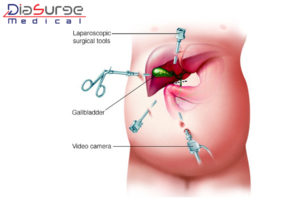Dr. Kamal ArefConsultant General Surgery and Laparoscopic SurgeryNMC Royal Hospital, Khalifa City, Abu Dhabi, United Arab Emirates Laparoscopic appendectomy must be the gold standard.Nowadays, many centers still continue to go on with McBurney’s incisions. Why? Expensive devices may be a reason.Low cost appendectomy allows for a diagnostic laparoscopy and offers a therapeutic option with the lowest price.On the other hand, residents must begin the learning curve in laparoscopy as soon as possible not only with a training center (training in cadaveric or animals) but they must also start practicing on humans with watchful surgeon/teacher’s eyes.My aim is to demonstrate that low-cost laparoscopic appendectomy is feasible not only for surgeons but also for residents operating with an expert.
1) Introduction;
Appendicectomy is the most frequent surgery in emergency cases. Nowadays the laparoscopic approach is the golden standard. As the economic crisis has become a tough reality, it is crucial to minimize the cost of surgery. It includes how to create the pneumoperitoneum, the material used, how to control the appendiceal artery and base, as well as the way to take the specimen out of the abdomen.This can be applied with 3 clinical cases(a- Phlegmonous appendicitis, b- Retrocaecal appendicitis, c- Perforated appendicitis)
It will be as follow;
1-Peumoperitoniem
2- Instrumentation
3- Appendiceal artery control
4- Appendiceal base control
5- Specimen extraction
6- Three clinical cases;
– Phlegmonous appendicitis
– Retrocaecal appendicitis
– Perforated appendicitis
2) Instrumentation;
2- position of the patient= same as classical for Laparoscopic appendicectomy
3- position of the team= same as classical for Laparoscopic appendicectomy
4- position of the canulas= use Hassan method(open method)
5- How to create Peumoperitoniem= no change as the usual method
6- Examples;
6.1- Phlegmonous appendicitis
6.2- Retrocaecal appendicitis
6.3- Perforated appendicitis
Three ports are required and introduced in an atraumatic way without their blade;
-A simple Mosquito opens the peritoneum; a 10mm, 30-degree optic is used.
-All the instrumentation is reusable.
-Six threads of 3/0 PDS line are required.
-A finger of a sterilized glove is prepared with silk suture around it.
2- Position of the patient;
The patient lies in a supine position with the justify arm tucked alongside the body to provide both surgeon and assistant with a comfortable space.The Surgeon stands directly across the right iliac fossa facing the primary monitor,The camera holder stands on the surgeon’s right.
3- position of the team;
The Surgeon stands against Lt iliac fossa facing the primary monitor and the camera holder assistant stands on his right position.
4- position of the canulas;
One 10mm port is placed on the midline over the pubis, and the last 5mm port is placed in the inferior justify quadrant.
5- How to create Peumoperitoniem;
Establishment of the pneumoperitoneum is the most critical step of the surgery. A 10mm skin incision is performed, and after opening the underlying fascia and peritoneum, a canula without its blade is introduced in an atraumatic way.
6- How to perform the procedure/surgery;
After CO2 insufflation of peritoneum, the identification of the colon, caecum will lead us to the appendix and mesoappendix, You can hold the tip of appendix up by other insstrument or fixed by sling stitching through abdominal wall on mosquito outside the abdomen.By cautery make a window at the appendix near the base of appendix make adouble knots by using ligature and cut inbetween.Make a double knots by using ligature and cut in between at the base of appendix 1cm from the caecal junction with the base of the appendix,The next step is specimen extraction; finger of a sterilized glove is prepared with silk suture around it, by which appendix is extracted via the 10mm trocar.Suction irrigation to be done using reusable suction irrigation instrument,Desufflation and suturing the wounds.



